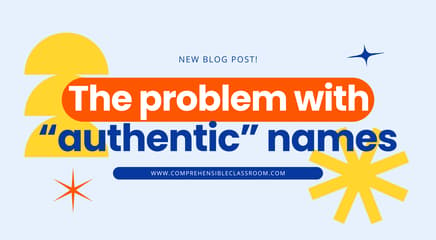One common question that I was asked in my sessions at iFLT '14 was, "I thought that our goal is to provide students with comprehensible input...so why do so many of these activities contain output?" Great question!
Is output bad?
No comprehension based teacher thinks that output is bad. Output is a good thing and one of the end goals for our courses, but it is not the primary means by which we acquire language. Comprehension based teachers focus on input because research shows that students acquire language when they listen to or read language at i+1 (one step above their current level of proficiency). The main focus of our instruction, therefore, is finding ways to provide our students with comprehensible input using strategies like PQA, MovieTalk, Embedded Reading, Storyasking, and more.
Output is always present in language classes
That being said, we do not eliminate output from our classes. CI classes are filled with output! As Carol Gaab so brilliantly pointed out in one of her sessions at iFLT 2014, PQA itself--perhaps the most basic and essential tool to the CI teacher--depends on output. Teachers ask questions to students (input), then students answer the questions orally (output) before the teacher takes their answer and discusses it with the class. It is a constant back-and-forth of input and output!

Does output have any value?
I believe that there is value in giving students opportunities to produce output. I also believe that there is value in giving students limited opportunities to practice (!!!) output.
When students have the opportunity to speak the target language, their confidence and competence grows. They get to feel the words in their mouth and they realize that they really can use the target language. Or, maybe, they identify some holes that they need to fill in--like, "how SHOULD I pronounce that word, anyway?". I think about myself as a French learner--the instances in which I am able to speak French--even to myself--are highly motivating to me. I love feeling like I can speak a new language!!
Output generates input. Allowing learners to imperfectly express an idea has many times generated compelling input in my classes. Students have great ideas. Often, they are much more interesting than we are! The ideas that they express via output are often our best inspiration for input. One sentence of output could generate an entire class period of input! Let your students talk and write so that you can talk with them and their classmates about their awesome ideas!
Output activities keep the class engaging. If all they ever did was listen and read, they would not stay in our classes. Limited output allows us to use many different activities that will help maintain engagement.
Many output activities (especially Cooperative Learning activities) allow for MOVEMENT. In our sedentary culture with sedentary schools, giving students the chance to stand up and move around is beneficial for their learning. Cooperative Learning activities are--in a sense--Brain Breaks!
My advice for using output activities
If you, like me, have considered the research and decided--as an educated professional--that you want to use output activities in class, I have three pieces of advice:
Limit, structure, and scaffold the output, especially in novice levels.
Limit time spent on output/communicative activities
At the conference, Karen Rowan suggested setting time limits for your output activities, and I agree wholeheartedly. Even though students may be able to spend 25 minutes on a communicative activity, it would be better to limit it to just 5 minutes in a novice class. As students move on into upper levels, they can spend more time with output because they will have built up their fluency. Here are two Cooperative Learning activities that can easily be kept to 5 minutes:
Structure the output
Many of the output activities that I use in novice classes are extremely structured. In many of the examples from my PQA Hooks presentation at iFLT14, students are using plug-and-play phrases to share their ideas (like "I'm going on a trip, and I'm going to bring ___", in which the only original component of the sentence is a noun). This way, students have an opportunity to speak and form an original idea, but the risk for inaccurate language is minimized.
Scaffold the output
Smother the output in input. Anytime a student shares an idea with the class (produces output), take that idea and smother it in input by asking circling questions, comprehension questions, and fishing for details.
Front-load the input. When you introduce a new set of structures, spend time doing PQA, Storyasking, and input-based story activities, and then assign an output-based activity. Consider basing the activity on questions that have already been discussed in class so that students know the answers to explicit recall questions and have already had an opportunity to formulate personal responses to opinion or analytical questions. (This is what I usually do for the Fan N Pick activity.)
How to manage and assess output activities
I also received a lot of questions about how I manage and assess the output. As far as management goes, please read this post about the hole puncher police. With regard to assessment, it depends on the level and on the activity.
I do not begin to formally assess speaking until late in Spanish 1, and even then it is a very small percentage of students' overall grade. (I use Standards Based Assessment, and my grading categories are based on skill--speaking, reading, writing, listening.) I do, however, strive to complete a minimum of three formative speaking assessments per marking period, even in my novice classes. As students advance into upper levels, I strive for an additional three summative speaking assessments--key word being strive, since it doesn't always happen. To do this, I simply make marks on rubric cards during output activities. I might not get around to every student during every output activity, but by spending a small amount of class time each day doing structured (oral) output, I am able to get to each student 3x throughout the course of the marking period.
To download the rubrics that I use and an explanation of how I use them, click here (they're free). The file contains five levels of ACTFL Proficiency-Level based rubrics and one Six Traits of Writing based rubric.





